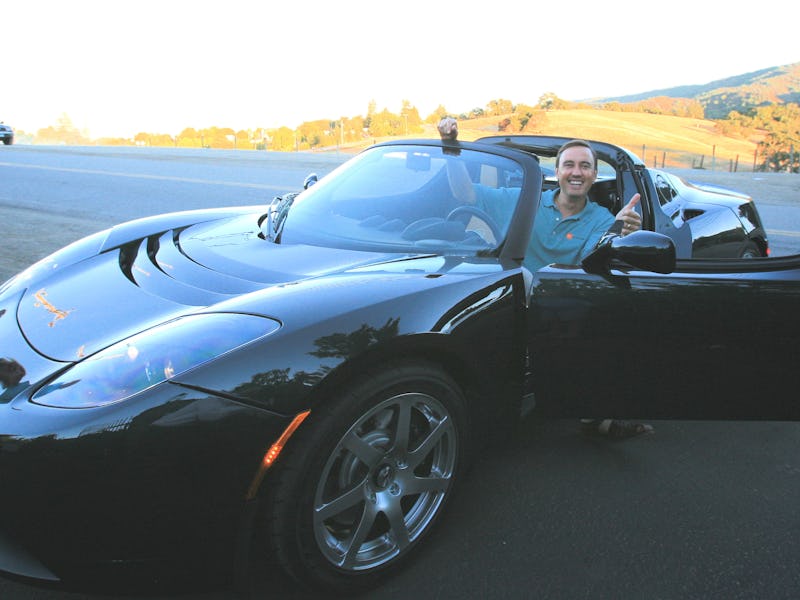Here's the Reason Car-Sharing Won't Kill the Auto Industry
It's so easy, it's brilliant.

The sharing economy is expanding to cars, but it might not create the massive disruption that Airbnb had on real estate prices and hotels, according to counterintuitive results from recent research.
A team of researchers at Carnegie Mellon University in Pittsburgh is working on a model to measure the impact of car sharing for automakers and consumers. Their early findings are surprising. It turns out that peer-to-peer car sharing can actually help automakers sell more cars.
“We were expecting that the [automakers] would be hurt,” Vibhanshu Abhishek, an economist from Carnegie Mellon and lead researcher on the paper, tells Inverse. “And that’s where the math comes in.”
Essentially, people who drive their car less often rent it out more, thereby making their car much more valuable to them. When a car makes money by being rented out, its owner is more likely to spend that money on a new car, making the car more attractive to people who want to rent it. Meanwhile, automakers will make fewer cars to sell at higher prices to owners who fully intend to rent them out. The cycle continues on like that.
But let’s back up for a second. A report on the projected effects of peer-to-peer car sharing on the auto industry from Boston Consulting Group, released in February 2016, all but spelled doom for automakers. The projections were that car sharing would crater car sales (emphasis ours):
“By 2021, 35 million users will book 1.5 billion minutes of driving time each month and generate annual revenues of €4.7 billion. Europe will be the biggest revenue-generating region, followed by Asia-Pacific and North America. Car-sharing will reduce worldwide vehicle sales by approximately 550,000 units by 2021 and cause a net revenue loss to OEMs of €7.4 billion.
In the face of this forecast and ones like it, car companies began partnering with car-sharing services to try and reduce losses. BMW expanded ReachNow, its car-sharing program, to Brooklyn this past year. And Toyota invested in GetAround, a peer-to-peer car-sharing startup. Not to be outdone, Elon Musk’s “Master Plan: Part Deux” for Tesla envisions a Tesla Network specifically for renting out Teslas when they’re not in use. There are also indies like Turo, which found that, actually, a lot of its rides were dope.
Some day you could just pick up a Tesla at a charging station and go.
Back at Carnegie Mellon, Abhishek and his team wanted to figure out how much the car-sharing industry would hurt automakers, given the projections. To do this, they have modeled a number of scenarios based on how people used their cars, and the economic pressures.
“There are some people who use their cars a lot and some people who don’t use their cars very much,” says Abhishek. “Like me — my car is lying around except for these special occasions when I need to get groceries.”
Although their results are still in the early stages, so far the team has found out this: In areas where there is variety in how people use their cars, peer-to-peer car sharing helped both the consumers and the automakers. Being able to rent out your car when you’re not using it makes cars more valuable.
“It increases the value of the product for people who end up buying,” Abhishek says.
With any luck cars of the future will look cooler than this.
For the car company, Abhishek says, “it doesn’t have to produce as many goods as it did earlier, but people are willing to spend a lot more money.”
The increased cost is going to hit the people who use their cars a lot, as the sharing economy doesn’t help them very much. On average, these people are more likely to be able to afford slightly higher car prices, says Abhishek, because they are still getting a high amount of value from the car. When there isn’t very much variety in how people use their cars, or there is huge variety in how people use their cars – think a town with daily drivers and once a month drivers only – the economic pressures are a little different.
The results show that the degree of consumer heterogeneity in usage rates continues to play a fundamental role. Indeed, under intermediate levels of consumer heterogeneity in usage rates, the incumbent firm can be better off by embracing the presence of P2P rental markets. In contrast, if heterogeneity in usage rates is too low, the OEM prefers to operate as a sales-only monopoly, whereas if heterogeneity is too high, the OEM prefers to operate as a Dual firm that offers both sales and rentals directly to consumers.
When autonomous cars enter the scene, Abhishek thinks they will change how we see car ownership even more. With an autonomous car, the car would basically pay for itself, he says. Or we could just see a market where no one owns cars except for companies like Uber or Ford, who rent them to people.
Car companies have already started trying out what the subscription model would look like, which lets you upgrade to the newest car as if it were a new iPhone, or purchase a car with a group of people with similar driving habits. Soon, you won’t have to own a car to have the coolest new tech.